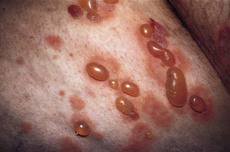153 Bullous eruption
Salient features
Examination
• Bullous eruption (Fig. 153.1)
• Crusts or superficial erosions (these suggest a preceding fluid-filled lesion).
• Comment on the distribution: knee, thighs, forearms and umbilicus in the elderly (pemphigoid).
• Look in the mouth for ulceration; if the blisters break easily leaving denuded skin, it is more likely to be pemphigus.
• Tell the examiner that a biopsy of the skin is essential to confirm the diagnosis.
Advanced-level questions
Mention a few blistering conditions
What are the forms of pemphigus?
There are two main forms; both occur commonly in middle age:
• Pemphigus vulgaris and its variant pemphigus vegetans; the vulgaris form begins in the mouth in over 50% of cases
• Pemphigus foliaceus and its variant pemphigus erythematosus, which are more superficially blistering conditions; the foliaceus form may be drug induced (e.g. penicillamine toxicity) or is associated with autoimmune disease.
How would you manage generalized forms of autoimmune bullous disease?
• The treatment of patients with autoimmune blistering diseases is grounded in clinical experience rather than randomized controlled trials.
• Systemic steroid therapy is usually chosen first to treat patients with generalized forms of any autoimmune bullous disease except those mediated by immunoglobulin A. Topical steroids have little, if any, value in the treatment of such patients, although they are sometimes effective in patients with localized disease.
• Other immunosuppressive drugs: many patients with moderate to severe pemphigus, bullous pemphigoid, cicatricial pemphigoid or epidermolysis bullosa acquisita require a second immunosuppressive drug (such as azathioprine or cyclophosphamide), either for its corticosteroid-sparing effect or to achieve complete remission. The specific choice is a matter of personal experience, concern over the relative toxic effects and possible contraindications. Some patients have been treated successfully with prednisone and ciclosporin, but the latter alone is not beneficial. Low-dose methotrexate plus prednisone may benefit patients with pemphigus or bullous pemphigoid.
• Azathiprine is usually as used as steroid-sparing agent. Alternatives include methotrexate, intravenous chlorambucil, cyclophosphamide and mycophenolate mofetil.
• Dapsone and related drugs: dapsone is the drug of choice for patients with dermatitis herpetiformis or linear immunoglobulin A dermatosis who are not allergic to sulphonamides. It inhibits the chemotaxis of neutrophils, reducing their accumulation in the upper dermis and thus diminishing tissue inflammation. The response is rapid, with most lesions resolving within 48–72 h. Alternatives to dapsone include sulfapyridine, sulfoxone sodium and sulfamethoxypyridazine. Dapsone is effective as monotherapy in only a minority of patients with bullous pemphigoid.
• Chrysotherapy: systemic gold is rarely used as an alternative or adjunct to prednisone therapy in patients with pemphigus because it is efficacious in only a subgroup of patients and carries the potential risk of side effects on prolonged administration.
• Intravenous immunoglobulin therapy, intravenous rituximab, is usually reserved for patients with recalcitrant disease.
• Plasmapheresis: is used in patients with severe pemphigus unresponsive to conventional therapy and high titres of pemphigus autoantibodies. Plasmapheresis may also be beneficial in patients with bullous pemphigoid even in the absence of detectable autoantibodies, although its mechanism of action in such patients is not known.
• Gluten-free diets are advised in dermatitis herpetiformis.
• Other therapies: extracorporeal absorption of antibodies for pemphigus, combination tetracycline and nicotinamide in bullous pemphigoid, colchicine in immunoglobulin A dermatosis.








